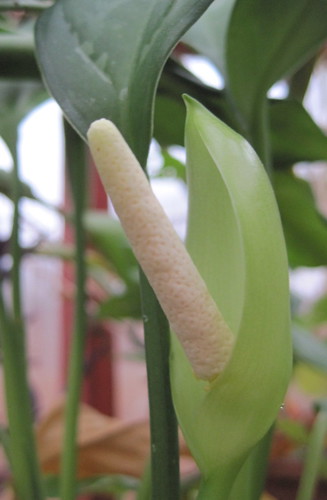One of my
Aglaonemas has produced it's first inflorescence, and another is on the way. This particular plant is not a flashy hybrid and I had some help deducing the name of
Aglaonema commutatum v. maculatum f. maculatum. These older species Ags are not grown as often now, since there are so many different hybrids with silvery foliage that really stands out. But I really like this plant and I'm happy to have the opportunity to see it flower.
 |
| Aglaonema commuatum v. maculatum f. maculatum inflorescence |
This "bloom" is not called a flower, because it is actually a large collection of many flowers. All Aroids have these complex blooms called inflorescences. The center column is called the spadix and contains male flowers, female flowers and sterile flowers (in some genera). In order for reproduction to take place, the pollen from the male flowers must reach the female flowers by a pollinator. In some species, the female flowers are hidden within a chamber of the surrounding leaf, which is called the spathe. I was able to capture a nice close-up so that you can see the female flowers, which are at the bottom of the spadix, but not hidden with this species. The female flowers are distinct and easy to pick out right now, while the rest of the spadix just looks like a white blob. The male and female flowers are mature at different times in order to ensure that the pollination takes place by a different plant (cross-breeding) so that genetic diversity continues. Some species will allow for self-pollination, but this plant does not. Eventually that white blog of a spadix will look a little more distinct as the male flowers become mature and produce pollen.
 |
| Detail of Aglaonema commuatum v. maculatum f. maculatum inflorescence |
When successful pollination occurs, the flowers will turn into berries containing seed (infructescence). These are usually brightly colored - white, yellow, orange or red - and will either fall off the spadix or be eaten by a bird or other animal that deposits the seed which can grow into a new plant.
If I have the chance to collect pollen from my male flowers, I will try to store it for use in pollinating a future flower from any of my other Aglaonemas. A successful pollination could mean a new hybrid.


No comments:
Post a Comment